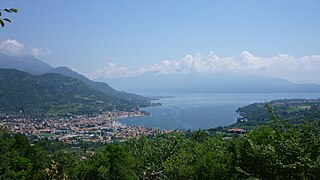
Salò is a town and comune in the Province of Brescia in the region of Lombardy on the banks of Lake Garda, on which it has the longest promenade. The city was the seat of government of the Italian Social Republic from 1943 to 1945, with the ISR often being referred to as the "Salò Republic".

The church of Santa Maria dei Miracoli is located on Corso Vittorio Emanuele in Brescia.
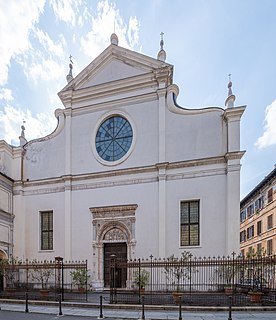
The church of Santa Maria delle Grazie in Brescia is located on at the west end of Via Elia Capriolo, where it intersects with the Via delle Grazie. Built in the 16th century and remodeled in the 17th century, it still retains much of its artwork by major regional artists, including one of its three canvases by Moretto. The other two are now held at the Pinacoteca Tosio Martinengo. The interior is richly decorated in Baroque fashion. Adjacent to the church is the Sanctuary of Santa Maria delle Grazie, a neo-gothic work.
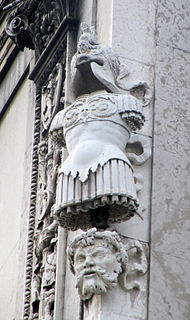
Gasparo Cairano, also known as Gasparo da Cairano, de Cayrano, da Milano, Coirano, and other variations, was an Italian sculptor of the Renaissance.

Antonio Mangiacavalli was an Italian sculptor of the Renaissance.
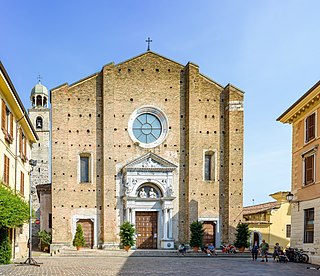
Santa Maria Annunziata is the main religious building (duomo) of the town of Salò, Italy.
Antonio della Porta, better known as Tamagnino was an Italian sculptor of the Renaissance.

Bernardino delle Croci was an Italian goldsmith and sculptor of the Brescian Renaissance. He was the founder of the Delle Croci family of important goldsmiths and sculptors, known for their specialism in processional crosses, reliquaries and altars.

Palazzo della Loggia is a Renaissance palace situated in the eponymous piazza in Brescia.

The Tomb of Gaspare Brunelli is a funerary monument in partially painted and gilded marble by Gasparo Cairano, dating to 1500, and situated in the Sacred Heart chapel of the Church of St Francis of Assisi, Brescia.
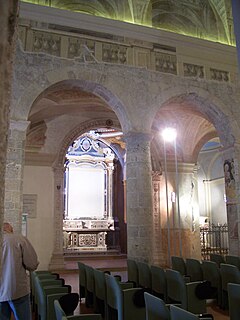
The Caprioli Chapel is the second chapel on the left side of the nave of the Church of San Giorgio in Brescia.

Chiesa di San Giovanni Evangelista Organ Case is a set of four tempera on canvas paintings produced by Moretto da Brescia, c. 1535. The inner sides show stories from the life of John the Baptist and scenes from the life of John the Evangelist. They now hang on the walls of the chancel of the church for which they were painted, San Giovanni Evangelista in Brescia.

The Sant'Eufemia Altarpiece is a 1526-1530 oil on panel painting by Moretto da Brescia, originally on the high altar of Sant'Afra in Brescia and now in the Pinacoteca Tosio Martinengo in the town. The Sant'Afra Reliquary was also based on the painting. The painting's lower register shows saints Benedict of Nursia, Euphemia, Justina and Paterius.

The Luzzago Altarpiece is a 1542 oil on canvas painting by Moretto da Brescia, now in the Pinacoteca Tosio Martinengo in Brescia. It was recorded in San Giuseppe church in Brescia in 1630 and moved to its present home in 1868. In the lower register Michael the Archangel points the kneeling donor to the Madonna and Child above, whilst Francis of Assisi stands to the right with a cross.

St Margaret of Antioch with Two Saints is a 1530 oil on panel painting by Moretto da Brescia on display on the side-altar of St Jerome in the church of San Francesco in Brescia. To the left of Margaret of Antioch is shown Saint Jerome, whilst to the right is Francis of Assisi.

The Holy Cross Standard is a 1520-1521 oil on canvas painting by Moretto da Brescia, commissioned by the Brescia's city council for the Company of the Guardians of the Holy Cross, guardians of the Sante Croci treasury at the city's Old Cathedral. It is now in the Pinacoteca Tosio Martinengo in the city.

Maffeo Olivieri was an Italian sculptor and wood carver. Often associated with his younger brother Andrea, he was active in Lombardy, Venice and Trentino. He was known for his bronze, wood and marble creations, and considered the premier sculptor in early sixteenth century Brescia.

The Ark of Sant'Apollonio is a funerary monument in marble by Gasparo Cairano. Dated between 1508 and 1510, it is located in the third chapel on the right of the southern nave of the New Cathedral, Brescia.

The Ark of San Tiziano is a marble tomb attributed to the Sanmicheli studio. Finished in 1505, it is located in the Church of the Saints Cosma and Damiano in Brescia, in the chapel dedicated to these saints.
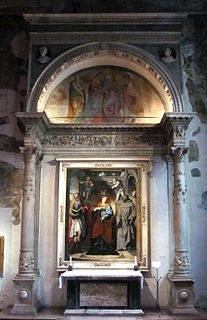
The Altar of San Girolamo is a sculptural complex in marble, around 780×450×80cm in dimension, designed and constructed by Gasparo Cairano and Antonio Medaglia, and situated within the Church of St Francis of Assisi in Brescia, Italy. Dated between 1506–1510, it is located in the first chapel on the right side of the nave.



















